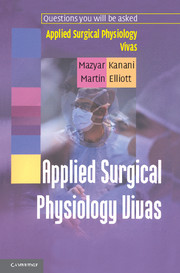Book contents
- Frontmatter
- Contents
- List of Abbreviations
- Dedication
- Preface
- A Change in Posture
- Acid-Base
- Action Potentials
- Adrenal Cortex I
- Adrenal Cortex II – Clinical Disorders
- Adrenal Medulla
- Arterial Pressure
- Autonomic Nervous System (ANS)
- Carbon Dioxide Transport
- Cardiac Cycle
- Cardiac Output (CO)
- Cell Signalling
- Cerebrospinal Fluid (CSF) and Cerebral Blood Flow
- Colon
- Control of Ventilation
- Coronary Circulation
- Fetal Circulation
- Glomerular Filtration and Renal Clearance
- Immobilization
- Liver
- Mechanics of Breathing I – Ventilation
- Mechanics of Breathing II – Respiratory Cycle
- Mechanics of Breathing III – Compliance and Elastance
- Mechanics of Breathing IV – Airway Resistance
- Microcirculation I
- Microcirculation II
- Micturition
- Motor Control
- Muscle I – Skeletal and Smooth Muscle
- Muscle II – Cardiac Muscle
- Nutrition: Basic Concepts
- Pancreas I – Endocrine Functions
- Pancreas II – Exocrine Functions
- Potassium Balance
- Proximal Tubule and Loop of Henle
- Pulmonary Blood Flow
- Renal Blood Flow (RBF)
- Respiratory Function Tests
- Small Intestine
- Sodium Balance
- Sodium and Water Balance
- Starvation
- Stomach I
- Stomach II – Applied Physiology
- Swallowing
- Synapses I – The Neuromuscular Junction (NMJ)
- Synapses II – Muscarinic Pharmacology
- Synapses III – Nicotinic Pharmacology
- Thyroid Gland
- Valsalva Manoeuvre
- Venous Pressure
- Ventilation/Perfusion Relationships
Cell Signalling
Published online by Cambridge University Press: 06 January 2010
- Frontmatter
- Contents
- List of Abbreviations
- Dedication
- Preface
- A Change in Posture
- Acid-Base
- Action Potentials
- Adrenal Cortex I
- Adrenal Cortex II – Clinical Disorders
- Adrenal Medulla
- Arterial Pressure
- Autonomic Nervous System (ANS)
- Carbon Dioxide Transport
- Cardiac Cycle
- Cardiac Output (CO)
- Cell Signalling
- Cerebrospinal Fluid (CSF) and Cerebral Blood Flow
- Colon
- Control of Ventilation
- Coronary Circulation
- Fetal Circulation
- Glomerular Filtration and Renal Clearance
- Immobilization
- Liver
- Mechanics of Breathing I – Ventilation
- Mechanics of Breathing II – Respiratory Cycle
- Mechanics of Breathing III – Compliance and Elastance
- Mechanics of Breathing IV – Airway Resistance
- Microcirculation I
- Microcirculation II
- Micturition
- Motor Control
- Muscle I – Skeletal and Smooth Muscle
- Muscle II – Cardiac Muscle
- Nutrition: Basic Concepts
- Pancreas I – Endocrine Functions
- Pancreas II – Exocrine Functions
- Potassium Balance
- Proximal Tubule and Loop of Henle
- Pulmonary Blood Flow
- Renal Blood Flow (RBF)
- Respiratory Function Tests
- Small Intestine
- Sodium Balance
- Sodium and Water Balance
- Starvation
- Stomach I
- Stomach II – Applied Physiology
- Swallowing
- Synapses I – The Neuromuscular Junction (NMJ)
- Synapses II – Muscarinic Pharmacology
- Synapses III – Nicotinic Pharmacology
- Thyroid Gland
- Valsalva Manoeuvre
- Venous Pressure
- Ventilation/Perfusion Relationships
Summary
1. Which parts of a cell express receptors?
Receptors may be located at the cell membrane, or within the cytosol of the cell.
2. Can you name the four main types of receptor involved in cellular signalling? Give some examples.
Ion channel linked receptor: e.g. nicotinic cholinoceptors at the neuromuscular junction
G-protein coupled receptor: e.g. muscarinic cholinoceptors and adrenoceptors
Tyrosine kinase linked receptor: e.g. various growth factors, insulin receptor
Intracellular receptor: steroid hormone receptors
3. What basically happens when a ligand binds to a G-protein coupled receptor?
Receptoro stimulation by the ligand causes binding of the receptor to its G-protein. This causes the G-protein to release (inactive) guanosine diphosphate (GDP) and uptake (active) guanosine triphosphate (GTP). Depending on the type of G-protein that the receptor is coupled to, the G-protein may then activate the enzyme adenylyl cyclase, or inhibit it, or it may stimulate the enzyme phospholipase C.
4. What are the components of the G-protein?
This is composed of α, β and γ subunits:
α subunit: variation in this determines the type of G-protein. This component binds to GDP and GTP
β and γ components bind reversibly to the α subunit
5. What is the functional significance of the α subunit?
This determines the type of G-protein and therefore its function. There are several types of α subunit, each linked to a particular type of G-protein. Three examples are:
Gs: receptor binding to this system leads to activation of adenylyl cyclase, e.g. occurs with β1- and β2-adrenoceptor stimulation and glucagon signals through this pathway
[…]
- Type
- Chapter
- Information
- Applied Surgical Physiology Vivas , pp. 40 - 43Publisher: Cambridge University PressPrint publication year: 2004



